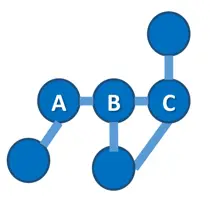Practice More Quizzes:
Q:
Network analysis has grown out of different academic disciplines, which leads to sometimes confusing nomenclatures. Which of the following has the same meaning as node/points in networks?
Q:
Network analysis has grown out of different academic disciplines, which leads to sometimes confusing nomenclatures. Which of the following has the same meaning as links/lines in networks?
Q:
What is A in the following network?
Q:
What is A in the following network?

Q:
Which of the following is an undirected network?
Q:
What is the relationship between links and degrees in a network?
Q:
What is a common prediction we can make when seeing that person A has two friends who do not know each other?
Q:
In network analysis, the difference between a walk and a path is:
Q:
In the network below, what CANNOT be used to describe the walk 1-2-3-1?
Q:
People often talk about ‘degrees of separation’ in network analysis. The more technical and precise term for the kind of ‘separation’ they are talking about is:
Q:
A friend of your cousin has a buddy, whose mom’s nephew has a friend who knows the First Lady. How many degrees of separation are between you and the First Lady?
Q:
Google is an extremely extensive network that reaches more than one in six people worldwide. This phenomena is known as the famous six degrees of separation. True or False.
Q:
A colleague of your aunt’s friend knows Lionel Messi. How many degrees of separation are between you and the famous soccer player?
Q:
In Social Network Analysis, there is a clear mathematical meaning if you are part of a ‘clique’. It means that:
Q:
Which type of centrality is best for defining the center of the network?
Q:
Which statement is correct? Degree Centrality measures:
Q:
Which statement is correct? Closeness Centrality measures:
Q:
When you assess how distant nodes are from each other in a network, you are effectively assessing:
Q:
When you assess how often nodes are on shortest paths between other nodes in a network, you are effectively assessing:
Q:
Which statement is correct? Betweenness Centrality measures:
Q:
Which statement is correct? Eigenvector Centrality considers:
Q:
When your centrality assessment considers how many links are connected to the nodes connected to your node of interest, you are assessing which of the following:
Q:
Your new employer aims to fight the spread of fake news with a new algorithm designed by a group of ingenious computational social scientists. The problem is that running the algorithm is so expensive that it can only be installed at one single point in a given network. The goal is to delete fake news as often as possible when it spreads from everyone to everyone in the network. You are the newest member of this all-star team, and it is your task to determine where at which node to install it. You suggest to detect the node with the optimal:
Q:
Your new employer starts a marketing campaign with the goal of giving each existing client at least one gift in the quickest way possible, but the gift should come from another existing client. So an existing client gets to give one gift to another existing client, who in turn gets to give one gift to another client, etc. (the same clients can be involved multiple times). Your boss asks you which individual client to invite to the kick-off launch of the campaign. In order to to reach each one in the network with the fewest number of steps, you suggest inviting the client with the optimal:
Q:
As part of a marketing campaign, your new employer tries to understand who of its identified clients are the Twitter users with the most followers. They are effectively looking for what network measure?
Q:
Which node has the highest closeness centrality? What are the “raw closeness counts” for [A,B,C]?

Q:
Which node has the highest closeness centrality? What are the “raw closeness counts” for [A,B,C]?

Q:
Which node has the highest closeness centrality? What are the “raw closeness counts” for [A,B,C]?

Subscribe
0 Comments
Find Questions in This Page: "CTRL+F"
